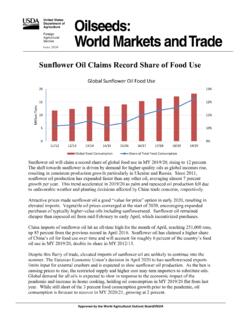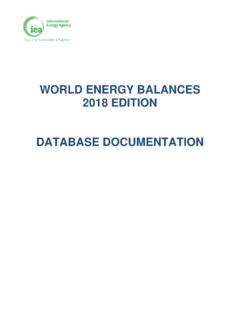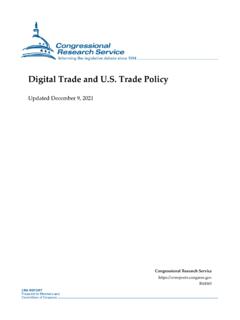Transcription of Information Systems for Business and Beyond (2019)
1 Information Systems for Business and Beyond (2019) Information Systems for Business and Beyond (2019) Information Systems , their use in Business , and the larger impact they are having on our world. DAVID BOURGEOIS JOSEPH MORTATI, SHOUHONG WANG, AND JAMES SMITH Information Systems for Business and Beyond (2019) by David Bourgeois is licensed under a Creative Commons Attribution-NonCommercial International License, except where otherwise noted. This book was initially developed in 2014 by Dr. David Bourgeois as part of the Open Textbook Challenge funded by the Saylor Foundation. This 2019 edition is an update to that textbook. This book was produced with Pressbooks ( ) and rendered with Prince. Information Systems for Business and Beyond Updated edition: August 1, 2019 DAVID T. BOURGEOIS, JAMES L. SMITH, SHOUHONG WANG, JOSEPH MORTATI, MBA Title Page | vCopyright Information Systems for Business and Beyond (2019) by David Bourgeois is licensed under a Creative Commons Attribution-NonCommercial International License, except where otherwise noted.
2 Vi | CopyrightBook Contributors Information Systems for Business and Beyond was originally developed in 2014 by David T. Bourgeois Updates for the 2019 edition were graciously contributed by: James L. Smith (all chapters) Shouhong Wong, (chapters 4 and 8) Joseph Mortati, MBA (chapter 10) Book Contributors | viiChanges from Previous Edition Information Systems for Business and Beyond was written by Dr . David Bourgeois and originally published in 2014 as part o f the Open Textbook Challenge at the Saylor Foundation. Since then, it has been accessed thousands of time and used in many c ourses worldwide. This 2019 update to the textbook brings it up to date and adds many ne w topics. True to its open textbook roots, many of the updates have c ome from the community o f instructors and practitioners who are passionate about Information Systems .
3 See the page Book Contributors to se e the primary c ontributors to this edition. A majority o f the changes listed below w ere made by Dr . James Smith, who did a revision to this text in 2018. Here is a summary of the changes made: Overall New and updated images, especially those related to statistics, in order to bring them up to date. References brought up to date. Added labs for every chapter. Added an index. Editing for consistency. Chapter 1: What is an Information system ? Added video: Blum s fibre optic TED Talk viii | Changes from Previous EditionChapter 2: Hardware Removed text which discussed increasing dependency on tablets and decreasing use of desktops Clarification of bit vs. byte, binary vs. digital. Added tables to Understanding Binary sidebar Added Huang s Law on graphics processor units Modified text regarding Moore s Law to state that his law is no longer able to be maintained Chapter 3: Software Added Information about Ubuntu Linux Added Eclipse IDE Added Information about Tableau Supply Chain Management: added an emphasis on use of Information Systems up and down supply chain by Walmart to gain competitive advantage Chapter 4: Data and Databases Database schemas redesigned Data types added SQL examples include output NoSQL described Data Dictionary re-ordered to column name New section on Why database technology?
4 Differentiation of data, Information , and knowledge Section on Data models Changed illustrative example of database tables and relationships. Changes from Previous Edition | ix Updated section on Business Intelligence to focus on the rise of analytics and data science. Includes a new What is Data Science? sidebar. Chapter 5: Networking and Communication History of ARPANET initial four nodes, etc. Metcalfe s Law Chapter 6: Information Systems Security Added Information on blockchain and Bitcoin. Chapter 8: Business Processes Introduce tools (DFD, BPMN, UML) of Business process modeling Introduce examples of DFD. Chapter 10: Information Systems Development Java sample code Mismanaging Change side bar Added section on mobile development. Added sidebar on risks of end-user computing x | Information Systems for Business and Beyond (2019)Chapter 11: Globalization and the Digital Divide World written by economist Pankaj Ghemawat; also his TED talk video Chapter 12: The Ethical and Legal Implications of Information Systems Facebook and Cambridge Analytics data privacy General Data Protection Regulation section Chapter 13: Trends in Information Systems Waze mapping app Drone video Drone blood delivery in Kenya video Added sidebar on Mary Meeker and her Internet Trends report Changes from Previous Edition | xiHow you can help This is an open textbook and relies on the support o f i ts users to stay relevant and available.
5 Here s how you can help: 1. Let us know you are using this textbook. If you are an instructor, please let us know you ve adopted this textbook by filling out the instructor survey. If you are not an instructor, please fill out the student survey. 2. Let us know how to improve the textbook. If you have suggestions, please let us know by filling out our feedback form. 3. Finally, the domain, web hosting, security, backup and export tools used by this textbook are not free. Please consider supporting us financially through PayPal. Please note: this donation goes directly to Imperial Digital LLC, the company hosting and supporting this open textbook project. All contribution are marked as donations towards this open textbook project. xii | How you can helpIntroduction Welcome to Information Systems for Business and Beyond .
6 In this book, you will be introduced to the concept of inf ormation Systems , their use in Business , and how Information Systems can be used to gain competitive advantage. Audience This book is written as an introductory te xt, meant f or those with little or no experience wi th c omputers or Information Systems . While sometimes the descriptions can get a bit te chnical, e very effort has been made to convey the Information essential to understanding a topic while not getting overly f ocused in detailed terminology. Chapter Outline The text is organized ar ound thirteen chapters divided in to three major parts, as follows: Part 1: What Is an Information system ? Chapter 1: What Is an Information system ? This chapter provides an overview of Information Systems , including the history of how Information Systems got to where it is today.
7 Chapter 2: Hardware This is a discussion of Information Introduction | 1systems hardware and how it works. You will look at different computer parts and learn how they interact. Chapter 3: Software Without software, hardware is useless. This chapter covers software and the role it plays in an organization. Chapter 4: Data and Databases This chapter explores how organizations use Information Systems to turn data into Information that can then be used for competitive advantage. Special attention is paid to the role of databases. Chapter 5: Networking and Communication Today s computers are expected to also be communication devices. This chapter reviews the history of networking, how the Internet works, and the use of networks in organizations today. Chapter 6: Information Systems Security This chapter discusses the Information security triad of confidentiality, integrity, and availability.
8 Different security technologies are reviewed, and the chapter concludes with a primer on personal Information security. Part 2: Information Systems for Strategic Advantage Chapter 7: Does IT Matter? This chapter examines the impact that Information Systems have on an organization. Can IT give a company a competitive advantage? This chapter discusses the seminal works by Brynjolfsson, Carr, and Porter as they relate to IT and competitive advantage. Chapter 8: Business Processes Business processes are the essence of what a Business does, and Information Systems play an important role in making them work. This chapter will discuss Business process management, Business process reengineering, and ERP Systems . Chapter 9: The People in Information Systems This chapter will provide an overview of the different types of people involved in Information Systems .
9 This includes 2 | Information Systems for Business and Beyond (2019)people who create Information Systems , those who operate and administer Information Systems , those who manage Information Systems , and those who use Information Systems . Chapter 10: Information Systems Development How are Information Systems created? This chapter will review the concept of programming, look at different methods of software development, review website and mobile application development, discuss end-user computing, and look at the build vs. buy decision that many companies face. Part 3: Information Systems Beyond the Organization Chapter 11: Globalization and the Digital Divide The rapid rise of the Internet has made it easier than ever to do Business worldwide. This chapter will look at the impact that the Internet is having on the globalization of Business and the issues that firms must face because of it.
10 It will also cover the concept of the digital divide and some of the steps being taken to alleviate it. Chapter 12: The Ethical and Legal Implications of Information Systems The rapid changes in Information and communication technology in the past few decades have brought a broad array of new capabilities and powers to governments, organizations, and individuals alike. This chapter will discuss the effects that these new capabilities have had and the legal and regulatory changes that have been put in place in response. Chapter 13: Future Trends in Information Systems This final chapter will present an overview of some of the new technologies that are on the horizon. From wearable technology to 3-D printing, this chapter will provide a look forward to what the next few years will bring. Introduction | 3 For the Student Each chapter in this text begins with a list of the relevant le arning objectives and ends with a chapter summary.









